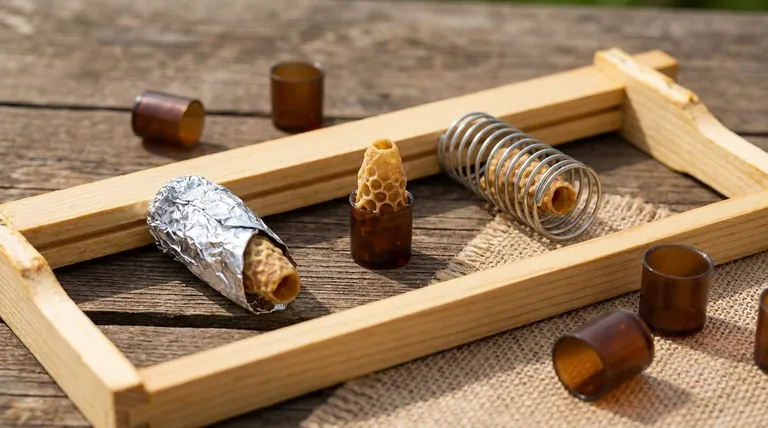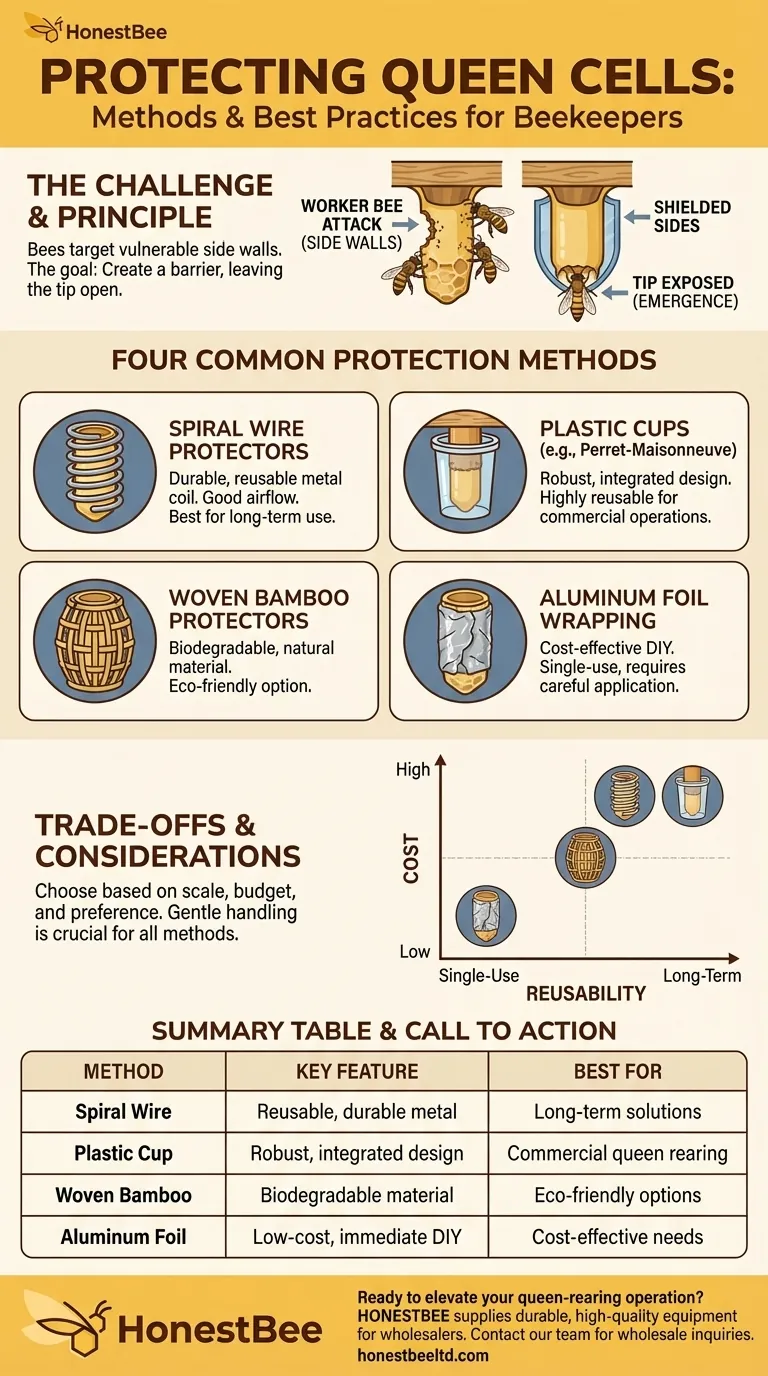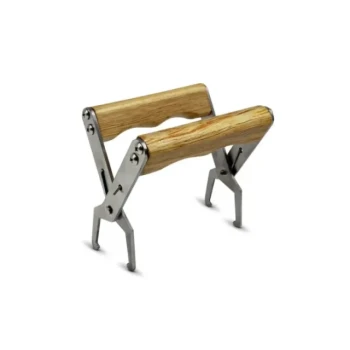To protect a queen cell from being destroyed by worker bees, you must physically shield its vulnerable side walls. The most common methods involve using spiral wire protectors, specialized plastic cups like the Perret-Maisonneuve, woven bamboo cages, or a simple wrapping of aluminum foil. These tools create a barrier that prevents bees from chewing into the cell before the new queen can emerge.
The core principle behind any queen cell protector is to block worker bees from accessing the cell's sides, their primary point of attack. A successful protector shields the cell's body while leaving the tip exposed, allowing the virgin queen to emerge unimpeded at the proper time.

The Core Problem: Why Bees Destroy Queen Cells
To effectively protect a queen cell, you first need to understand the mechanics and motivation behind its destruction. The behavior is not random; it is a calculated act based on colony instinct.
The Method of Attack
Bees do not attack a queen cell from its tip. The cocoon is thickest at the bottom of the cell, making it tough and difficult to chew through.
Instead, worker bees chew into the side walls of the cell. Once they create a breach, they remove the developing queen pupa, effectively eliminating the potential rival.
The Motivation for Destruction
A colony's primary instinct is to remain "queenright" with a single, healthy, laying queen. They will destroy surplus or unacceptable queen cells for several reasons:
- The colony already has a queen they are satisfied with and view the new cell as a threat.
- The cell was introduced from another colony and carries an unfamiliar scent.
- The cell is damaged or contains a pupa the workers have deemed non-viable.
Common Protection Methods Explained
Each protection method operates on the same principle: shield the walls, leave the tip open. The primary differences are material, cost, and reusability.
Spiral Wire Protectors
These are simple, spring-like coils of wire. The protector is gently "screwed" or wound around the queen cell, encasing it in a metal cage.
This method is effective, durable, and can be used repeatedly for many seasons. The open structure allows for good air circulation around the cell.
Perret-Maisonneuve Cups
These are specially designed plastic cups that fully encase the queen cell. The cell is placed inside, and the cup is then attached to the frame.
They offer robust physical protection and are highly reusable. Their design often integrates easily with commercial queen-rearing frames and cell bars.
Woven Bamboo Protectors
As a natural alternative, small woven bamboo cages serve the same purpose. The queen cell is placed inside the cage, which protects it from the worker bees.
These appeal to beekeepers looking for biodegradable or plastic-free options, but they may be less durable than their metal or plastic counterparts.
Aluminum Foil Wrapping
This is a common and highly effective DIY method. A small piece of aluminum foil is carefully wrapped around the body of the queen cell.
It is crucial to leave the bottom tip of the cell uncovered. This is where the queen will chew her way out. The foil acts as a simple but impenetrable barrier against chewing.
Understanding the Trade-offs
While all methods can be successful, they come with different considerations. Choosing the right one depends on your goals, scale, and budget.
Cost vs. Reusability
Aluminum foil is the most cost-effective option, as it uses a common household product. However, it is a single-use solution and requires manual shaping for every cell.
Wire and plastic protectors have a higher initial cost but are designed for long-term, repeated use. This makes them more economical for beekeepers who rear queens regularly.
Application and Risk
Every method requires a gentle hand. Queen cells, especially in their later stages, are extremely fragile.
Applying too much pressure with a wire protector or while wrapping foil can crush the cell and kill the developing queen. Plastic cups can sometimes make handling the delicate wax cell base easier.
Making the Right Choice for Your Hive
Selecting a protection method is a practical decision based on the specific needs of your beekeeping operation.
- If your primary focus is cost-effectiveness and immediate availability: Use the aluminum foil method, ensuring you wrap carefully and leave the tip exposed.
- If your primary focus is durability and long-term use: Invest in spiral wire protectors or plastic cups for a reusable and efficient solution.
- If your primary focus is using natural, biodegradable materials: Woven bamboo protectors offer a functional, plastic-free alternative.
By understanding the bees' behavior and choosing the right shield for the job, you can dramatically increase the success rate of your queen-rearing and introduction efforts.
Summary Table:
| Method | Key Feature | Best For |
|---|---|---|
| Spiral Wire Protector | Reusable, durable metal coil | Beekeepers seeking a long-term solution |
| Plastic Cup (e.g., Perret-Maisonneuve) | Robust, integrated design for cell bars | Commercial queen rearing operations |
| Woven Bamboo Protector | Biodegradable, natural material | Beekeepers preferring eco-friendly options |
| Aluminum Foil Wrapping | Low-cost, readily available DIY method | Cost-effective, immediate protection needs |
Ready to elevate your queen-rearing operation? HONESTBEE supplies durable, high-quality beekeeping supplies and equipment—including queen cell protectors—to commercial apiaries and beekeeping equipment distributors through our wholesale-focused operations. Let our expertise help you achieve higher success rates and greater efficiency. Contact our team today to discuss your specific needs and discover the right equipment for your business!
Visual Guide

Related Products
- Brown Nicot Queen Cell Cups for Breeding Queen Bees Beekeeping
- JZBZ Push-In Queen Cell Cups for Beekeeping
- Professional Queen Catcher and Introduction Queen Cage
- JZBZ Langstroth Queen Rearing Frame for Beekeeping
- Stainless Steel Queen Grafting Tool for Beekeeping and Bee Queen Grafting
People Also Ask
- What are the signs that a queen cell is about to emerge? Master the Critical Timing for Hive Success
- How many cells are given to a nucleus? Understand the One-to-One Rule in Cell Biology
- What should be done with extra queens from grafting? A Strategic Guide for Apiary Management
- Why is it important to select a healthy larva less than 24 hours old for queen rearing? Maximize Queen Quality and Colony Strength
- What is the advantage of the Nicot Cupkit system? Secure Your Queen Rearing Success with Batch Protection



















